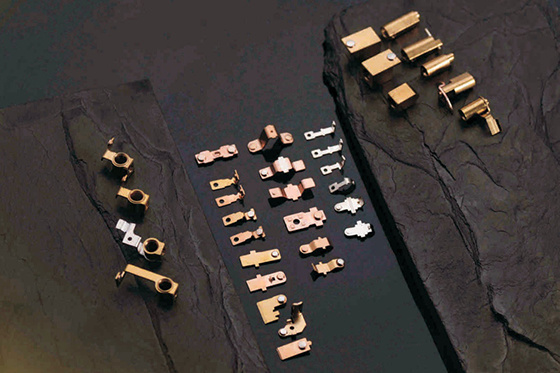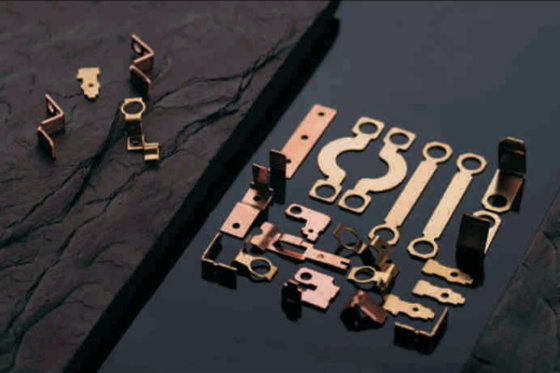2023-11-30
Disconnectable contacts are an indispensable part of switching appliances. According to their different structures, they can be divided into the following types: (1) Blade-shaped contact: Its structure is simple, divided into surface contacts and line contacts, and is widely used in low-voltage switches and high-voltage isolation switches. (2) Butt contact: It has the characteristics of simple structure and fast action speed, but the contact surface is unstable and changes greatly with pressure. It is easy to rebound when working, no self-cleaning effect, and the contact is easy to be burned by arc. This contact is usually used for distribution circuit breakers with rated current below 1000 amps and below 500 amps
2023-11-30
What is the principle of relay?
It is composed of a magnetic circuit part and a contact part. The magnetic circuit part is composed of an iron core, an armature, an iron, a short-circuit ring, a coil and a tension spring. It is characterized in that a sleeve on the iron core is installed between the coil and the egg iron. Side plate, and the side plate is in good contact with the iron core and iron. The utility model can short-circuit the magnetic flux leakage in the electromagnetic system by adding a side plate made of pure copper on the basis of the original relay, which reduces the eddy current loss and greatly reduces the communication when the relay coil is overloaded. The ending reduces the interference of the relay to other electronic equipment and improves the contact reliability of the contact.
2023-11-30
With the development of high voltage, large current, miniaturization and long life of switching devices, the electrical performance requirements of contact materials are getting higher and higher. Nano-contact materials have become a hot spot in the research and preparation of contact materials. Most of the research on nano-bulk contact materials is still in the laboratory stage, and there are still many problems to be solved in practical applications. The main reasons are:
2023-11-30
Switching capacity of electrical contacts
The material properties of contacts are one of the key factors that affect the working characteristics and electrical life of vacuum switchgear. Almost all early vacuum switches used tungsten, molybdenum and other refractory pure metals as contact materials. This contact material has a series of advantages, such as suitable breaking performance, good compressive strength and welding resistance, suitable thermal conductivity and electrical conductivity, low ablation rate during arc combustion, contact, long life, etc. Widely used in breaking small current vacuum switch. However, high melting point pure metal contact materials have many shortcomings, such as breaking current and high cut-off level, which limits the application range of vacuum switches.
2023-11-30
These relays contact protection and contact matters, everyone knows?
We know that the contact protection of relays is more cruel than Mosfet, and the load of ordinary relays is much larger than Mosfet. Typical DC large capacity DC motor, DC clutch and DC solenoid valve. These inductive load switches turn off, and surges due to back EMF of hundreds or thousands of volts may shorten or completely damage the contact life. Of course, if the current is small (for example, near 1A), the back electromotive force will produce arc discharge, and the discharge will cause the contact to be contaminated by metal oxide, which will cause the contact to be damaged and the contact resistance will increase. It is pointed out here that the relay will fail sooner or later. We mainly protect the contacts to extend the use time of the relay, because the contacts will always be carbon deposits, aging, and the surface is not as clean as it was.
2023-11-30
How to protect the circuit through relay contacts?
Under normal temperature and pressure, the key dielectric breakdown voltage in air is 200~300V. Therefore, our goal is generally to control the voltage below 200V or less. Through the relay contact protection circuit, we generally have the following centralized methods to suppress:
2023-11-30
Failure Analysis of Electrical Contact
Common control electrical products such as AC contactors, electromagnetic relays, electrical switches and air switches contain electrical contacts, and contacts are one of the most important components of these products. The reliability and service life of the product depend to a large extent on the contact performance, which is affected by factors such as contact material, load type, contact pressure, operating frequency and use environment. When these factors can not meet the requirements, there will be contact electrochemical corrosion, welding between contacts, fire, contact wear, contact resistance increase and other problems, resulting in unreliable operation, functional failure and even security risks.
2023-11-30
Those things about relays, contactors, electrical contacts, contacts
Those things about relays, contactors, electrical contacts, contacts. Regarding electromagnetic relays and contactors, I believe all electricians are familiar with them. Knowledge about these two kinds of electrical equipment has long been shared by many peers. Today, the author only supplements the contact knowledge of electromagnetic relays and contactors.
2023-11-30
Arc Extinguishing Method for the Contact of Low-voltage Switchgear
Arc Extinguishing Method for the Contact of Low-voltage Switchgear 1. Contact resistance of contacts of low-voltage switchgear The contacts of low-voltage switchgear are an important part of the actuator. The contacts of low-voltage switchgear are used to connect and disconnect the circuit, so the electrical and thermal conductivity required by the contacts is very good. Generally, the contact material is an alloy material of copper, silver and nickel, and it is also formed by plating silver and nickel on the surface of the copper contact.
2023-11-30
Classification and application of electrical contacts and contacts-silver contacts
Classification of electrical contacts According to their contact mode, electrical contacts can be divided into the following three types 1) Fixed connection contacts. Refers to an electrical contact that cannot move relatively between the contact and the connected conductor. Such as bus connectors, electrical equipment lead connections. 2) Sliding contact. A contact mode in which the guide bodies can be kept in contact with each other but one contact surface is allowed to move relatively along the other contact surface is called sliding contact. For example, the expansion joint of the bus bar and the brush of the motor are in sliding contact.












